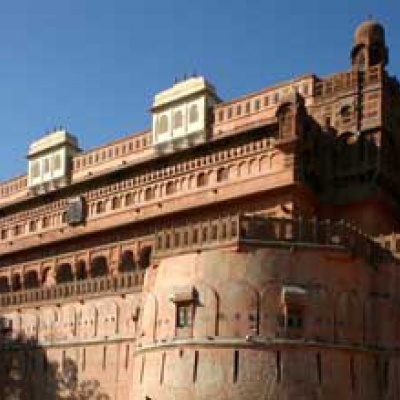
Bikaner
Bikaner was founded by Roa Bika 1488AD and he was the son of the founder of Jodhpur Roa Jodha. He chose a spot in the barren wilderness and transformed it into an impressive city. Later in 1880AD Maharaja Ganga Singh dug the Gang canal thus ensuring water for the surrounding landscape. In the past Bikaner flourished because of its location on the caravan trade route.
Today Bikaner is a vibrant desert town that has a population of half a million people (small by India's standards). The star attractions are the Junagarh Fort, and the old city. Close to the Old fort is the old walled city with its medieval maze of narrow streets. Junagarh fort is protected by a large sandstone wall and a moat.
Being in such an isolated location in the Thar Desert meant that the Fort was never conquered. For this reason Junagarh is well preserved and within its walls there are beautifully decorated palaces, temples and pavilions.
An bazaar and excellent tourist spot in bikaner is located near Kote Gate and here it is possible to find local handicrafts such as rugs and carpets, products made from camel hide and miniatures in Bikaneri style. Local snacks and sweets are also for sale here. Located nearby are Ramparia and Kothari Haveliswhich are ornate buildings constructed in the 17th and 18th centuries by Bikaner’s wealthy merchants.
Bikaner is famous for its Camels and located near Bikaner is the Government National Research Centre specializing in camel research. The Government camel breeding farm can be found 9km southeast of Bikaner. It was set up in 1975 and breeds nearly half of the camels in India. It is best to visit here in the late afternoon when the camels return from their grazing.
Many tourist peoples and travellers travel to Bikaner to visit the famous Karni Mata Temple at Deshnokewhere rats are worshipped. The Karni Mata Temple is located 30 km south of Bikaner at Deshnoke but is generally visited while people stay in Bikaner.
It was constructed by Maharaja Ganga Singh in the early 1900s as a tribute to the rat goddess, Karni Mata. The temple is home to 20,000 rats. Karni Mata, was a mystic matriarch from the 14th century, and thought to be an incarnation of Durga, the goddess of power and victory.
When the child of one of her clansmen died she attempted to bring it back to life. However Yama, the god of death told her the child had already been reincarnated. Karni Mata bargained with Yama to make a promise that all the people from her tribe would be reborn as rats until they could be born back into the clan.
In Hinduism,this cycle of transmigration is known as samsara and this is why Karni Mata's rats are treated like royalty. Devotees coming to the temple make offerings to them generally in form of milk, grains,and sweets.